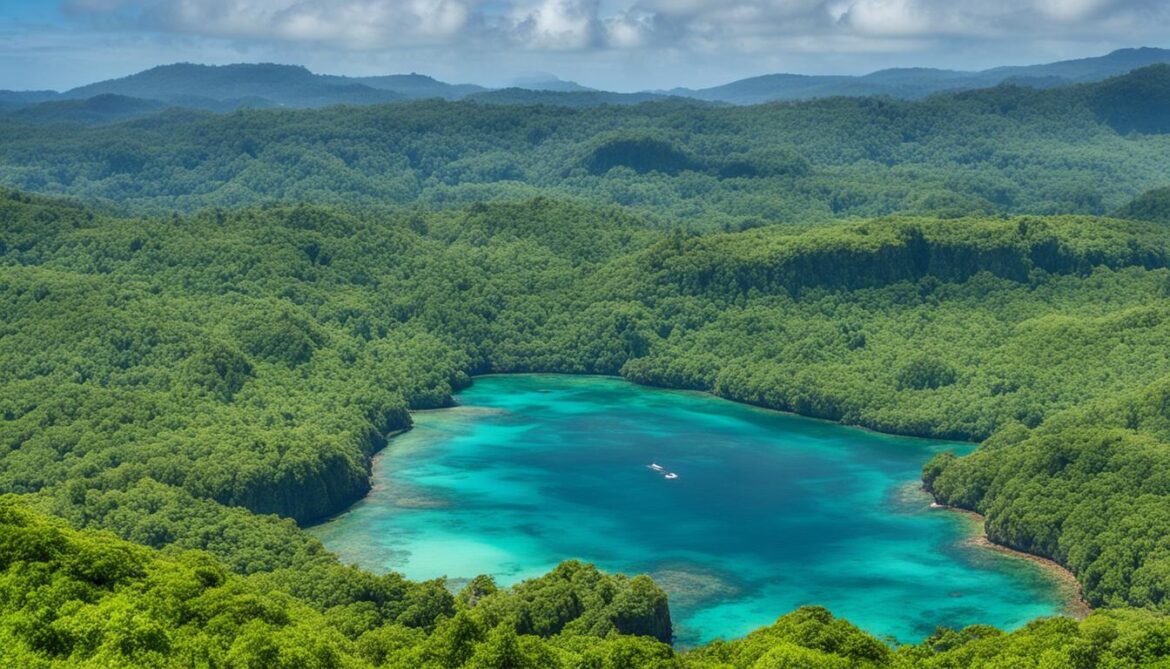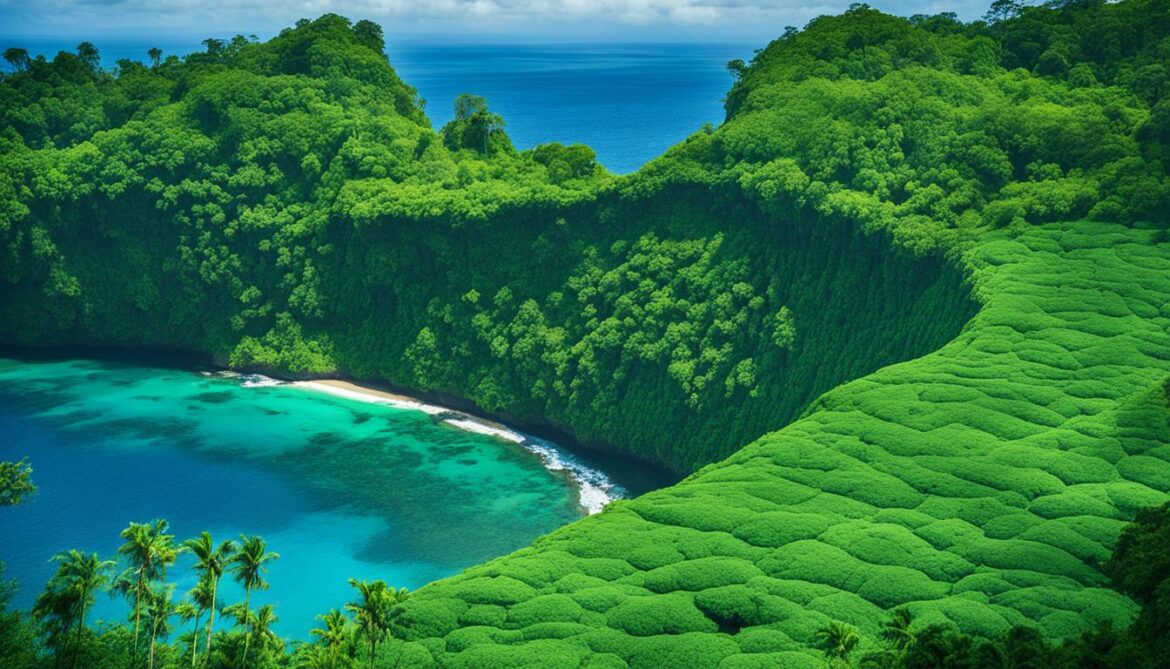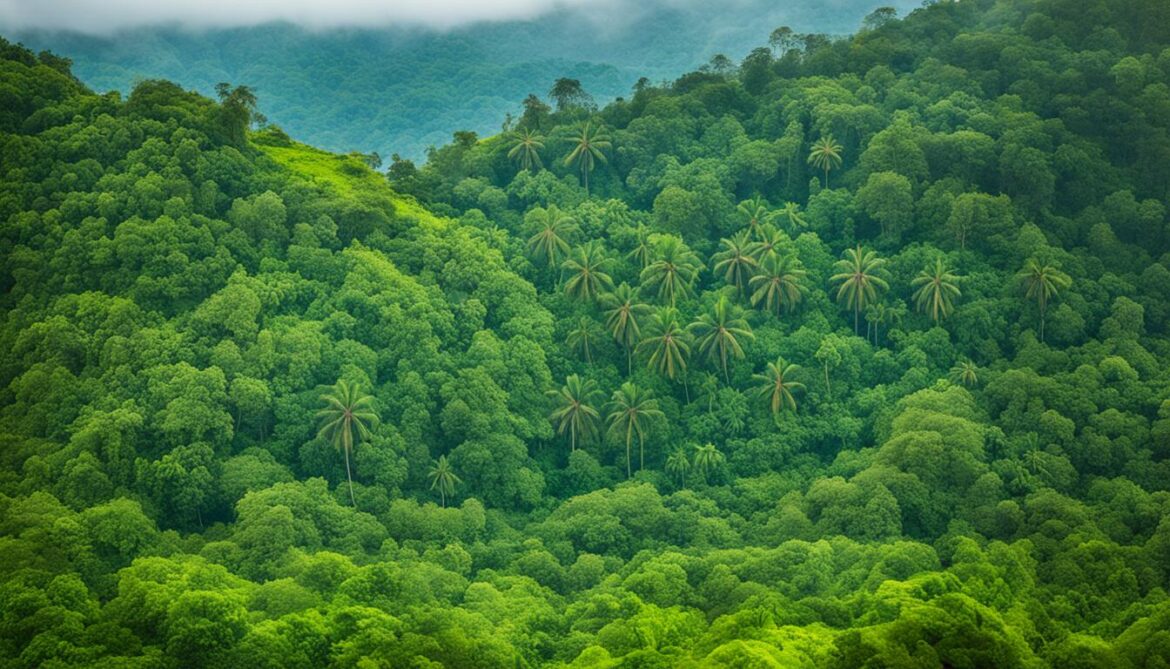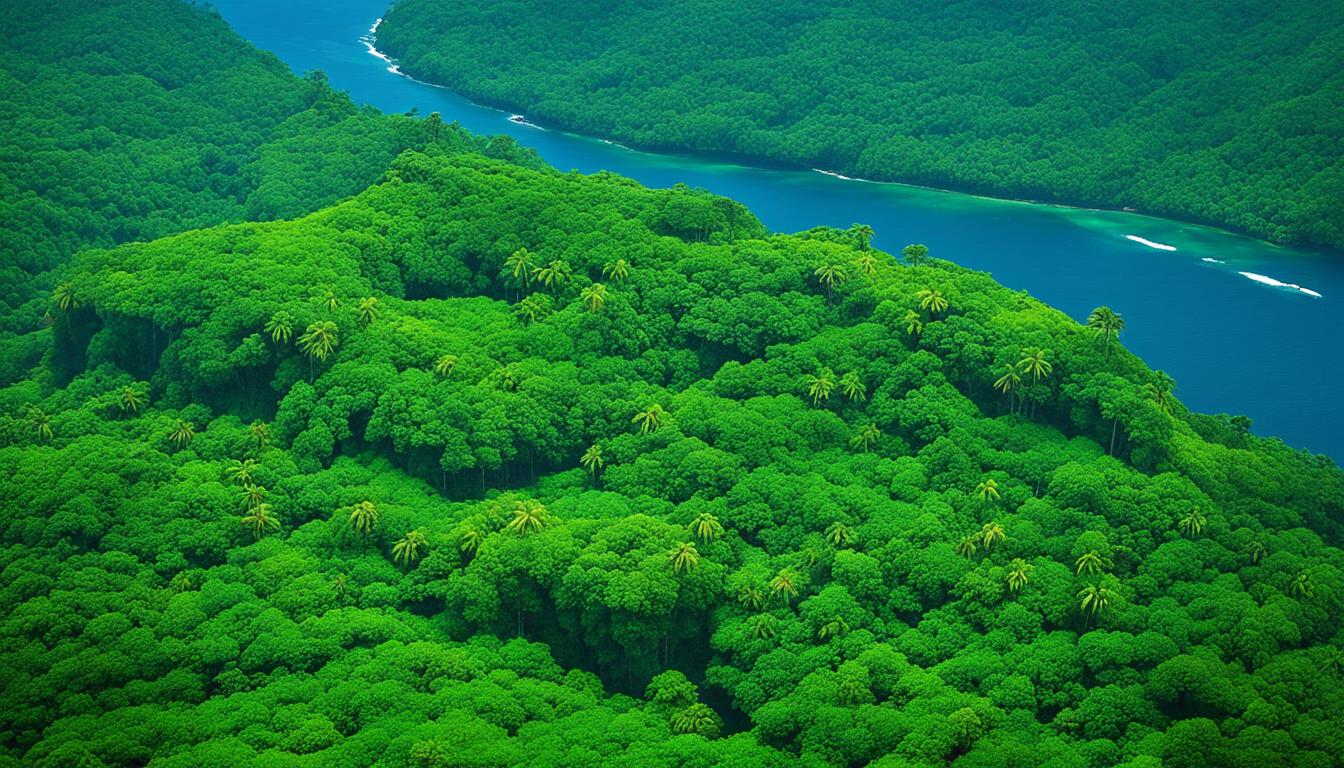Did you know that São Tomé and Príncipe, a volcanic island nation off the coast of West Africa, was once covered in native forests? However, over the centuries, most of these forests have disappeared. Despite the loss of forested areas, São Tomé and Príncipe are still considered a biodiversity hotspot, with a high level of endemism. The islands are home to a wide range of unique and endemic species, making them an important area for conservation efforts.
Key Takeaways:
- São Tomé and Príncipe is a volcanic island nation off the coast of West Africa.
- The islands were once covered in native forests, but most of them have disappeared.
- São Tomé and Príncipe is considered a biodiversity hotspot with a high level of endemism.
- The islands are home to a wide range of unique and endemic species.
- Conservation efforts are crucial in preserving the biodiversity of São Tomé and Príncipe.
The Importance of Biodiversity Hotspots
Biodiversity hotspots, such as São Tomé and Príncipe, are crucial areas that preserve a remarkable array of unique and endemic species. These hotspots serve as havens for biodiversity, with the tropical forests found on the islands playing a pivotal role in supporting a diverse range of plant and animal life. Their significance extends beyond their intrinsic beauty, as biodiversity hotspots deliver essential ecosystem services that contribute to our well-being.
These valuable ecosystem services include food production, climate regulation, and the provision of timber resources. Tropical forests within biodiversity hotspots are vital for food security, offering sustenance to both local communities and global populations. Additionally, these forests have a profound impact on climate regulation, helping to mitigate climate change by absorbing carbon dioxide and providing vital oxygen. Moreover, they provide timber resources, supporting industries and livelihoods that rely on sustainable forestry practices.
However, despite their incalculable value, biodiversity hotspots face severe threats, primarily due to deforestation and habitat loss. The destruction of tropical forests within these hotspots has dire consequences for countless species, disrupting intricate ecological relationships and reducing genetic biodiversity. As the delicate balance is disturbed, the survival of numerous species hangs in the balance.
“Biodiversity is the food we eat, the water we drink, and it is the air we breathe.”
The urgent need to protect and conserve biodiversity hotspots, such as São Tomé and Príncipe, cannot be overstated. By safeguarding these natural treasures, we ensure the long-term preservation of diverse species, the continued provision of essential ecosystem services, and the sustainability of our planet. The responsibility to protect and restore these hotspots lies with all of us, as we strive to create a harmonious coexistence with the natural world.
| Tropical Forests |
Species |
Ecosystem Services |
| Rich and diverse habitats that support a variety of plant and animal life |
Unique and endemic species that rely on these forests for survival |
Food production, climate regulation, and timber resources |
| Under threat due to deforestation and habitat loss |
Vulnerable to population decline and extinction |
Impacted by the disruption of ecological relationships |
| Require conservation efforts to ensure their preservation |
Depend on our collective responsibility as stewards of the environment |
Necessitate sustainable practices and protection from further degradation |
Forest Loss and Degradation in São Tomé and Príncipe
São Tomé and Príncipe, a beautiful island nation off the coast of West Africa, has sadly experienced significant forest loss and degradation over the years. In 1999, it was estimated that 61% of the country was covered by forests and 29% by shade plantations. However, these numbers only tell part of the story, as they do not reflect the recent trends of forest loss or differentiate between native forests and degraded ecosystems dominated by introduced species.
The islands’ growing population and economy have played a role in the loss of native forests. As land becomes scarcer, people increasingly turn to the forest for resources, leading to further deforestation and forest degradation. This trend is particularly concerning as native forests are integral to the unique biodiversity of São Tomé and Príncipe, supporting numerous endemic species that rely on these habitats for survival.
The loss of native forests not only affects the flora and fauna of São Tomé and Príncipe but also poses a threat to the overall health of the island ecosystems and the well-being of the local communities.
The loss and degradation of forests have far-reaching implications. Native forests provide critical ecosystem services, such as regulating the climate, maintaining water quality, and supporting pollinators. Additionally, they are essential for the livelihoods of local communities who depend on the forest for food, medicine, and other natural resources.
Efforts to address forest loss and degradation in São Tomé and Príncipe must prioritize the protection and restoration of native forests. This involves implementing sustainable land-use practices, promoting agroforestry systems, and raising awareness about the importance of forest conservation for the long-term well-being of both the environment and local communities.
The Impact of Shade Plantations
While shade plantations can provide an alternative source of income for farmers and contribute to the economy of São Tomé and Príncipe, it is essential to recognize that they cannot fully replace the vital ecosystem functions of native forests. Compared to native forests, shade plantations have limited biodiversity and provide fewer ecosystem services. It is crucial to strike a balance between economic development and forest conservation, ensuring that shade plantations are established in a sustainable and responsible manner.

A Call for Action
The alarming rate of forest loss and degradation in São Tomé and Príncipe calls for urgent action. Conservation organizations, government bodies, and local communities must work together to implement effective strategies for forest protection and restoration. This includes strengthening legislation and enforcement against illegal logging, promoting sustainable land-use practices, and engaging in reforestation initiatives.
By addressing the complex issues of forest loss and degradation, São Tomé and Príncipe can secure a sustainable future that protects the unique biodiversity of the islands while improving the well-being of its people.
| Forest Loss and Degradation Challenges |
Conservation Solutions |
| Loss of native forests |
Implement sustainable land-use practices |
| Increased deforestation |
Strengthen legislation against illegal logging |
| Scarcity of resources |
Promote sustainable agroforestry systems |
| Degraded ecosystems |
Engage in reforestation initiatives |
Conservation Challenges in São Tomé and Príncipe
São Tomé and Príncipe, known for its biodiversity and natural beauty, faces several challenges in conservation practices. While the islands have established protected areas like the Obô Natural Park and the Natural Park, there are notable differences in how conservation efforts are implemented between the two.
Príncipe stands out with its stricter regulations and robust enforcement against illegal logging, prioritizing the preservation of its forests. However, São Tomé, the larger and more populous island, struggles with illegal logging activities and limited resources for conservation initiatives.
Part of the reason behind these challenges is the socio-economic context of the islands. Poverty and political instability exacerbate the difficulties faced in conservation, where limited funding and resources hinder comprehensive protection efforts. In addition, conflicting interests arise between conservation and economic development, making it a delicate balancing act for policymakers.
Despite these obstacles, both islands are dedicated to preserving their unique ecosystems and natural heritage. The conservation community continues to work towards finding sustainable solutions that promote biodiversity and meet the needs of local communities.
The Impact of Illegal Logging
Illegal logging poses one of the most significant threats to the conservation of São Tomé and Príncipe’s forests. The practice not only contributes to deforestation but also disrupts the delicate balance of the islands’ ecosystems. It undermines the efforts made by protected areas and conservation organizations, putting endemic species and their habitats at risk.
To effectively combat illegal logging, stronger enforcement and collaboration between governmental bodies, local communities, and international organizations are crucial. By addressing the root causes of this issue and implementing effective measures, São Tomé and Príncipe can better protect their forests and ensure their sustainable use for future generations.
“Preserving the natural beauty and biodiversity of São Tomé and Príncipe is not only essential for environmental conservation but also for the sustainable development and well-being of the local communities.”
Conservation Practices and Strategies
To address the conservation challenges, São Tomé and Príncipe need to prioritize sustainable practices and develop comprehensive strategies. This includes strengthening the legal framework for conservation, providing adequate funding for protected areas management, and enhancing community engagement in conservation initiatives.
In Príncipe, where conservation practices are more advanced, the island can serve as a model for São Tomé. Sharing knowledge and expertise between the two islands can lead to a more unified approach to conservation in the archipelago.
Furthermore, international partnerships and collaborations with organizations such as the International Fund for Animal Welfare (IFAW) can bring additional support and resources to help address the conservation challenges faced by São Tomé and Príncipe.
Conservation Practices in São Tomé and Príncipe
|
São Tomé |
Príncipe |
| Protected Areas |
Struggles with limited resources |
Strong regulations and enforcement |
| Illegal Logging |
Faces challenges with illegal logging |
Robust enforcement against illegal logging |
| Conservation Strategies |
Needs to strengthen legal framework and community engagement |
Serves as a model with advanced conservation practices |

In conclusion, São Tomé and Príncipe’s conservation efforts are met with various challenges, including illegal logging and limited resources. By strengthening conservation practices, developing comprehensive strategies, and fostering international partnerships, the islands can work towards sustainable development and the preservation of their unique biodiversity.
Threats to Biodiversity and Human Well-being
The loss of forests and degradation of ecosystems in São Tomé and Príncipe poses significant threats to both biodiversity and human well-being. The relentless deforestation and habitat loss have resulted in a scarcity of resources for wildlife, which, in turn, has led to a decline in species populations. The delicate balance of nature is disrupted, with devastating consequences for the unique and endemic species that call these islands home.
While the impact on wildlife is evident, the effects on local populations should not be overlooked. The scarcity of forest resources, including timber and essential protein sources like snails and fish, directly impacts the livelihoods of the people who rely on them. The loss of these resources leaves communities struggling to meet their basic needs and exacerbates the already challenging socioeconomic conditions on the islands.
Compounding the issue is the poor quality of available timber and the lack of sustainable alternatives. The continuous degradation of forests limits the availability of high-quality timber, impacting construction, furniture production, and other industries. Without sustainable alternatives in place, the reliance on dwindling forest resources persists, perpetuating the cycle of habitat loss and scarcity.
The Way Forward
The conservation and preservation of São Tomé and Príncipe’s biodiversity require a multifaceted approach. Efforts must be directed towards addressing the root causes of habitat loss, such as unsustainable logging, deforestation for agriculture, and human encroachment. Implementing stricter regulations and enforcement measures, along with sustainable land-use practices, can help protect the remaining forests and restore degraded ecosystems.
Additionally, promoting sustainable alternatives to forest resources is vital for mitigating the impact on local communities. Initiatives that focus on sustainable agriculture, aquaculture, and the development of alternative building materials can help reduce reliance on the forest and provide alternative income opportunities.
“Conserving biodiversity is not only vital for the well-being of ecosystems but also for the long-term sustainability of human communities.” – Sustaining Life On Earth, World Wildlife Fund
Collaboration between government agencies, non-governmental organizations, local communities, and international partners is key to tackling the threats to biodiversity and human well-being. By working together and leveraging resources, expertise, and support, these stakeholders can implement comprehensive conservation strategies that address the interconnected challenges faced by São Tomé and Príncipe.
Ultimately, finding a balance between ecological preservation and the well-being of local communities is essential. Through sustainable practices and inclusive decision-making processes, we can ensure the long-term survival and prosperity of both the unique ecosystems and the people who call São Tomé and Príncipe home.

The Importance of Sustainable Development
Sustainable development plays a crucial role in addressing the challenges faced by São Tomé and Príncipe. It involves finding a balance between conservation efforts and economic growth to ensure the long-term well-being of both the environment and the local communities. By implementing sustainable development practices, we can protect biodiversity, ensure the availability of essential resources, promote economic opportunities, and improve livelihoods.
Conservation is a central component of sustainable development. It aims to preserve the delicate ecosystems and species found in São Tomé and Príncipe, safeguarding their unique biodiversity for future generations. Conservation practices include establishing protected areas, implementing sustainable resource management strategies, and raising awareness about the importance of biodiversity preservation.
Economic growth is equally important in sustainable development. By promoting responsible and inclusive economic activities, we can uplift local communities and provide them with the resources needed for a better quality of life. This can involve supporting sustainable industries, such as eco-tourism or organic agriculture, that generate income while minimizing negative environmental impacts.
One of the key benefits of sustainable development is that it fosters resilience. By adopting sustainable practices, São Tomé and Príncipe can reduce vulnerability to external shocks and disruptions. This resilience is essential for overcoming the challenges posed by climate change, economic fluctuations, and other unforeseen circumstances.
Sustainable development is not just about meeting our present needs; it is about ensuring that future generations can also thrive in a healthy and balanced environment. It requires us to think long-term and make decisions that prioritize the well-being of both people and nature.
Overall, the importance of sustainable development in São Tomé and Príncipe cannot be overstated. It provides a framework for achieving conservation goals while promoting economic growth and improving the lives of local communities. By embracing sustainable development practices, we can create a harmonious and prosperous future for São Tomé and Príncipe, where both nature and people can thrive.

The Role of Indigenous People and Local Communities
Indigenous culture, community conservation, and local leadership are integral to the preservation of São Tomé and Príncipe’s unique biodiversity. The knowledge and traditional practices of indigenous people contribute significantly to the sustainable use of natural resources and the conservation of cultural heritage.
Engaging with indigenous communities is crucial for effective and inclusive conservation efforts. By supporting community-led initiatives, we can ensure that local perspectives and expertise are valued and incorporated into conservation strategies. This approach fosters a sense of ownership and empowerment among community members, creating a sustainable and collaborative conservation model.
The Importance of Indigenous Culture
Indigenous culture holds a wealth of knowledge about the land, its ecosystems, and the interconnections between human and natural life. This knowledge, passed down through generations, provides valuable insights into sustainable resource management and the delicate balance between biodiversity conservation and human well-being.
Emphasizing indigenous cultural practices and their integration into conservation efforts not only supports biodiversity preservation but also strengthens the preservation of cultural heritage, fostering a sense of identity and pride among indigenous communities.
Community Conservation Initiatives
Community-led conservation initiatives harness the power of local knowledge, ensuring that conservation strategies are rooted in the needs, values, and aspirations of the communities who depend on the natural resources. These initiatives prioritize sustainable practices, promoting the protection of critical habitats, and ensuring the long-term survival of endemic species.
- Engaging in reforestation projects
- Implementing sustainable fishing practices
- Promoting eco-tourism as an alternative income source
These community-centered approaches not only promote biodiversity conservation but also support the social and economic well-being of local communities.
Local Leadership in Conservation
Local leadership plays a vital role in guiding conservation efforts, driving change, and ensuring the long-term sustainability of initiatives. By empowering local leaders, we empower the communities they represent, enabling them to take an active role in decision-making processes and the implementation of effective conservation strategies.
Local leaders act as catalysts for change, inspiring their communities and fostering a sense of collective responsibility towards the protection of their natural environment.
Through collaboration between local communities and various stakeholders, including government agencies, non-governmental organizations, and international partners, we can collectively address the conservation challenges faced by São Tomé and Príncipe. Together, we can create a future where indigenous culture is celebrated, community conservation thrives, and local leadership guides us towards the sustainable preservation of São Tomé and Príncipe’s rich biodiversity.
Indigenous Cultural Practices for Community Conservation
| Indigenous Cultural Practice |
Description |
| Traditional Agricultural Systems |
Integrating crop cultivation, livestock rearing, and agroforestry in a sustainable and harmonious manner. |
| Sacred Natural Sites |
Preserving areas of ecological and cultural significance through traditional management and reverence. |
| Ethnoecological Knowledge |
Systematically documenting and sharing indigenous knowledge about local ecosystems and species. |
| Traditional Fishing Practices |
Employing sustainable fishing techniques to protect marine biodiversity and ensure the livelihoods of fishing communities. |
| Community-Based Conservation Agreements |
Establishing agreements between indigenous communities and conservation organizations to collaboratively manage natural resources. |

Conservation Opportunities and Partnerships
Collaboration and partnerships are essential for successful conservation efforts in São Tomé and Príncipe. By working together with local communities, NGOs, government agencies, and international organizations, innovative and sustainable solutions can be achieved.
Conservation collaborations can involve a range of initiatives that have a lasting impact. One example is empowering landowners to become stewards of their natural resources. By providing them with the necessary tools, knowledge, and support, they can actively participate in conservation efforts and contribute to long-term sustainability.
Another important aspect is the provision of scholarships and skills building programs. By investing in the education and training of local communities, we can create a future generation of conservation leaders who are equipped with the necessary expertise to protect and preserve the unique biodiversity of São Tomé and Príncipe.
Improving access to clean water is also crucial for sustainable impact. Clean water is not only essential for human well-being but also for the health and survival of ecosystems. By implementing water conservation practices and infrastructure, we can ensure the availability of this vital resource for both people and nature.
By fostering partnerships and encouraging community participation, conservation goals can be achieved more effectively. The collaboration between local communities and various stakeholders creates a sense of ownership, shared responsibility, and a collective vision for a sustainable future.

In addition to local collaborations, international partnerships play a significant role in conservation efforts. Working with established organizations and experts from around the world brings valuable expertise, resources, and funding to support the conservation goals of São Tomé and Príncipe.
These partnerships can take different forms, such as research collaborations, capacity-building initiatives, and joint conservation projects. By pooling together knowledge, experience, and resources, we can develop innovative and effective strategies to address the conservation challenges faced by the islands.
Overall, through collaboration, local engagement, and sustainable partnerships, we can make a meaningful and lasting impact on the conservation of São Tomé and Príncipe’s unique biodiversity. Together, we can ensure the preservation of these precious natural resources for future generations.
| Conservation Opportunities and Partnerships |
Sustainable Impact |
| Empowering landowners |
Active participation in conservation efforts |
| Providing scholarships and skills building |
Education and training of local communities |
| Improving access to clean water |
Human and ecosystem well-being |
| Fostering partnerships and community participation |
Shared responsibility and sustainable vision |
The Importance of Africa Protected Areas Congress (APAC)
The Africa Protected Areas Congress (APAC) is a significant gathering that brings together stakeholders from government, private sector, civil society, academia, and Indigenous Peoples & Local Communities. APAC aims to highlight the importance of protected areas and biodiversity conservation in Africa, promoting sustainable development and mutual benefits for people and nature.
APAC provides a platform for sharing experiences, discussing challenges, and shaping the future of conservation efforts in the region. It serves as a catalyst for collaboration and innovation, fostering partnerships that can lead to impactful change.
The congress addresses critical topics related to protected areas and biodiversity conservation, such as the management and governance of protected areas, sustainable financing, community-led conservation initiatives, and the role of technology in conservation.
By convening a diverse group of stakeholders, APAC encourages knowledge exchange, cross-sectoral collaboration, and the development of practical solutions. It fosters dialogue between policymakers, practitioners, researchers, and local communities, ensuring that different perspectives are heard and integrated into conservation strategies.
Furthermore, APAC provides the opportunity for African countries to showcase their conservation successes, share best practices, and learn from each other’s experiences. It serves as a platform for celebrating achievements and identifying areas for improvement.
Through its inclusive and collaborative approach, APAC aims to inspire collective action and a shared commitment to biodiversity conservation. By working together, stakeholders can create a positive and sustainable impact on protected areas and the ecosystems they encompass.
IFAW’s Role in Conservation
The International Fund for Animal Welfare (IFAW) plays a crucial role in wildlife conservation efforts across Africa, including in Sao Tome and Principe. With a strong commitment to preserving biodiversity and promoting sustainable practices, IFAW actively engages with local communities to ensure positive and lasting change.
IFAW recognizes the importance of community engagement in wildlife conservation. By working closely with local residents, IFAW aims to empower them as stewards of their natural environment. This approach not only fosters a sense of ownership and responsibility but also ensures that conservation efforts align with the unique needs and perspectives of the community.
Through collaborations and partnerships, IFAW helps develop sustainable practices that benefit both wildlife and human well-being. By supporting local leadership and initiatives, IFAW promotes the development of solutions that are locally defined, culturally relevant, and environmentally sound.
“We believe in the power of community engagement to drive positive change in wildlife conservation. Bringing together the knowledge and experiences of local communities is essential for the long-term preservation of biodiversity and the well-being of people and animals alike.” – IFAW spokesperson
IFAW’s efforts in Sao Tome and Principe contribute to the vision of a world where animals and people can thrive together. By empowering communities, promoting sustainable practices, and finding locally defined solutions, IFAW is making a significant impact on wildlife conservation in the region.
IFAW’s Contributions to Wildlife Conservation in Sao Tome and Principe
| Initiative |
Impact |
| Community Training Programs |
Increase in local capacity for wildlife protection and conservation |
| Habitat Restoration Projects |
Enhanced biodiversity and ecosystem resilience |
| Anti-Poaching Campaigns |
Reduction in illegal hunting and wildlife trafficking |
| Education and Awareness Campaigns |
Raised public awareness about the importance of wildlife conservation |

IFAW’s commitment to community engagement and wildlife conservation is crucial for ensuring a sustainable future for Sao Tome and Principe’s unique biodiversity. By protecting and preserving the natural resources that both animals and humans depend on, IFAW is making a lasting positive impact in the region.
Conclusion
Sao Tome and Principe’s conservation efforts face significant challenges, including deforestation and habitat loss, which threaten the diverse and unique ecosystems found on the islands. Additionally, limited resources for conservation exacerbate these challenges. However, there is hope for the future.
By prioritizing biodiversity preservation and engaging with indigenous people, Sao Tome and Principe can make significant strides in protecting their natural heritage. Sustainable development practices and partnerships with local communities, NGOs, and government agencies can contribute to the long-term well-being of both the environment and the island’s inhabitants.
Through collaborative efforts, Sao Tome and Principe have the potential to create a future where nature and people thrive together. By safeguarding their sacred natural sites and preserving biodiversity, the islands can not only protect their invaluable natural assets but also promote economic growth, improve livelihoods, and ensure a sustainable future for generations to come.
FAQ
What is São Tomé and Príncipe?
São Tomé and Príncipe is a volcanic island nation off the coast of West Africa.
Why is São Tomé and Príncipe considered a biodiversity hotspot?
São Tomé and Príncipe is considered a biodiversity hotspot due to its high level of endemism and its wide range of unique and endemic species.
What are biodiversity hotspots?
Biodiversity hotspots are areas that contain a significant amount of unique and endemic species, such as São Tomé and Príncipe. These areas are crucial for biodiversity conservation.
What are the threats to biodiversity in São Tomé and Príncipe?
The main threats to biodiversity in São Tomé and Príncipe are deforestation and habitat loss caused by forest degradation and illegal logging.
What are the conservation practices in São Tomé and Príncipe?
São Tomé and Príncipe has protected areas in place, such as the Obô Natural Park and the Natural Park, but there are differences in conservation practices between the islands.
How does habitat loss affect human well-being?
Habitat loss through deforestation and degradation reduces the availability of resources for both wildlife and local populations, impacting their livelihoods.
Why is sustainable development important in São Tomé and Príncipe?
Sustainable development is crucial in São Tomé and Príncipe to balance conservation efforts with economic growth and ensure the long-term well-being of the environment and local communities.
What role do indigenous people and local communities play in conservation?
Indigenous people and local communities contribute to conservation efforts through their traditional practices and knowledge, ensuring the sustainable use of natural resources and the preservation of cultural heritage.
How can partnerships contribute to conservation efforts in São Tomé and Príncipe?
Collaborating with local communities, NGOs, government agencies, and international organizations can lead to innovative and sustainable solutions for conservation challenges in São Tomé and Príncipe.
What is the Africa Protected Areas Congress (APAC)?
The Africa Protected Areas Congress (APAC) is a significant gathering that brings together stakeholders to highlight the importance of protected areas and biodiversity conservation in Africa.
What is the role of the International Fund for Animal Welfare (IFAW) in conservation?
The International Fund for Animal Welfare (IFAW) actively contributes to conservation efforts across Africa, focusing on community engagement and collaboration to ensure positive and sustained change.
Source Links

























Post comments (0)